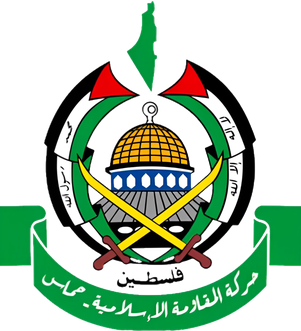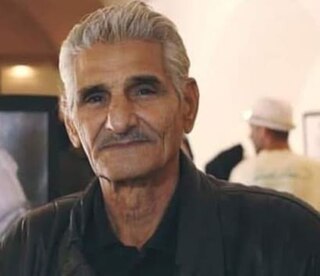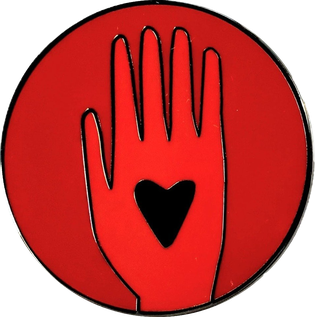

The watermelon is a symbol of Palestinians' public expression in protests and artworks, representing the struggle against the Israeli occupation of the Palestinian territories. [1] [2] [3]


The watermelon is a symbol of Palestinians' public expression in protests and artworks, representing the struggle against the Israeli occupation of the Palestinian territories. [1] [2] [3]
The Palestinian flag, coloured in the Pan-Arab colors of red, green, white and black, had been banned from 1967-1993 in Israel, leading to the locally-grown and similarly-coloured watermelon taking its place in Palestinian iconography as an alternative for decades. [4] Following the 1967 Six-Day War, Israel banned the display of the Palestinian flag and its colours in the Gaza Strip and the West Bank, with the Israeli army arresting anyone who displayed it. [5] [6]
In 1993, as part of the Oslo Accords, Israel lifted the ban on the Palestinian flag. [7] At the time, The New York Times claimed "young men were once arrested for carrying sliced watermelons", [8] but Palestinian artist Sliman Mansour has cast doubt on the validity of these claims. A later editor's note to the article says "Given the ambiguity of the situation, The Times should either have omitted the anecdote or made it clear that the report was unconfirmed." [8] He remembers a conversation about it, but does not recall any actual watermelon iconography being used until 2007, when Khaled Hourani created an image for a "Subjective Atlas of Palestine" project. Other artists who have used the watermelon include Sarah Hatahet, Sami Boukhari, Aya Mobaydeen and Beesan Arafat. [9]
The watermelon symbol is experiencing a revival, with a growing number of individuals leveraging it, along with watermelon emojis, on various social media platforms. [10] Although "shadow banning," a practice wherein users' posts are concealed without their awareness, may be challenging to detect, advocacy and nonprofit groups focused on digital rights in the Middle East assert that they have observed clear biases, particularly on Meta platforms such as Facebook and Instagram. Online users are adopting this symbol to enhance the visibility of their voices and mitigate shadow banning. The watermelon symbol serves as a means to circumvent censorship on social media channels. [11]

Hamas, an acronym of its official name, Harakat al-Muqawama al-Islamiya, is a Palestinian Sunni Islamist political and military movement governing the Israeli-occupied Gaza Strip since 2007.

The First Intifada, also known as the First Palestinian Intifada or the Stone Intifada, was a sustained series of protests, acts of civil disobedience and riots carried out by Palestinians in the Israeli-occupied Palestinian territories and Israel. It was motivated by collective Palestinian frustration over Israel's military occupation of the West Bank and the Gaza Strip, as it approached a twenty-year mark, having begun in the wake of the 1967 Arab–Israeli War. The uprising lasted from December 1987 until the Madrid Conference of 1991, though some date its conclusion to 1993, with the signing of the Oslo Accords.

Palestine, officially the State of Palestine, is a country in the southern Levant region of West Asia. It encompasses two disconnected territories — the West Bank and the Gaza Strip, collectively known as the Palestinian territories — within the larger region of Palestine. The country shares its borders with Israel to north, west and south, Jordan to the east and Egypt to the southwest. It has a combined land area of 6,020 square kilometres (2,320 sq mi) while its population exceeds five million people. Its proclaimed capital is Jerusalem while Ramallah serves as its administrative center and Rafah is currently its largest city. Arabic is the official language. The majority of Palestinians practice Islam while Christianity also has a significant presence.

The flag of Palestine is a tricolor of three equal horizontal stripes overlaid by a red triangle issuing from the hoist. This flag is derived from the Pan-Arab colors and is used to represent the State of Palestine and the Palestinian people.

Homosexuality in the Palestinian territories is considered a taboo subject; lesbian, gay, bisexual, and transgender (LGBT) people experience persecution and violence. There is a significant legal divide between the West Bank and the Gaza Strip, with the former having more progressive laws and the latter having more conservative laws. Shortly after the Jordanian annexation of the West Bank in 1950, same-sex acts were decriminalized across the territory with the adoption of the Jordanian Penal Code of 1951. In the Egyptian-occupied Gaza Strip and under Hamas' rule, however, no such initiative was implemented.

Israel and Indonesia have no formal diplomatic ties, although they maintain quiet trade, tourism and security contacts. In 2012, Indonesia spoke of upgrading relations with Israel and opening a consulate in Ramallah, but this agreement was never implemented.

The Green Brigade are a non sectarian Celtic F.C. supporter ultra group formed in 2006. They are situated in the North Curve corner section of Celtic Park.

The Battle of Gaza was a military conflict between Fatah and Hamas that took place in the Gaza Strip from 10 to 15 June 2007. It was a prominent event in the Fatah–Hamas conflict, centered on the struggle for power after Fatah lost the 2006 Palestinian legislative election. The battle resulted in the dissolution of the unity government and the de facto division of the Palestinian territories into two entities: the West Bank governed by the Palestinian National Authority (PNA), and the Gaza Strip governed by Hamas. Hamas fighters took control of the Gaza Strip, while Fatah officials were either taken as prisoners, executed, or expelled. The Palestinian Centre for Human Rights reported that at least 161 people were killed and more than 700 were wounded during the fighting.

The keffiyeh or kufiyyeh, also known in Arabic as a ghutrah (غُترَة), shemagh, or ḥaṭṭah (حَطَّة), is a traditional headdress worn by men from parts of the Middle East. It is fashioned from a square scarf, and is usually made of cotton. The keffiyeh is commonly found in arid regions, as it provides protection from sunburn, dust, and sand. An agal is often used by Arabs to keep it in place.

The Palestinian keffiyeh is a distinctly patterned black-and-white keffiyeh. Since the beginning of the Israeli–Palestinian conflict, it has become a prominent symbol of Palestinian nationalism, dating back to the 1936–1939 Arab revolt in Palestine. Outside of the Middle East and North Africa, the keffiyeh first gained popularity among pro-Palestinian activists; it is widely considered to be an icon of solidarity with the Palestinians in their fight against Israel.

The slogan of the Houthi movement, a Shia Islamist political and military organization in Yemen, reads "God Is the Greatest, Death to America, Death to Israel, A Curse Upon the Jews, Victory to Islam" on a vertical banner of Arabic text. It is often portrayed on a white background, with the written text in red and green colours derived from the flag of Iran; the pro-Islamic statements are coloured green while the statements about the United States, Israel, and the Jewish people are coloured red.

Ahed Tamimi is a Palestinian activist from the village of Nabi Salih in the Israeli-occupied West Bank. Best known for appearances in photos and videos in which she confronts Israeli soldiers, she has been hailed by pro-Palestinian activists as a symbol of Palestinian resistance against the Israeli occupation. Her memoir They Called Me a Lioness was published in 2022.

The Israel–Hamas war has sparked protests, demonstrations, and vigils around the world. These events focused on a variety of issues related to the conflict, including demands for a ceasefire, an end to the Israeli blockade and occupation, return of Israeli hostages, protesting war crimes, and providing humanitarian aid to Gaza. Protests against Israeli action in Gaza were notably large across the Arab world. Since the war began on 7 October 2023, the number of dead has exceeded 30,000.
The Israel–Hamas war has been extensively covered by various media outlets around the world. This coverage has been diverse, spanning from traditional news outlets to various social media platforms, and comprises a wide variety of perspectives and narratives.
Following the Hamas attack on Israel on 7 October 2023 and the outbreak of the Israel–Hamas war, there has been a surge of anti-Palestinianism, anti-Arab racism, and Islamophobia around the world. Palestinians have expressed concerns over increased anti-Palestinianism in mass media and anti-Palestinian hate crimes. Human rights groups have noted an increase in anti-Palestinian hate speech and incitement to violence against Palestinians.
Palestinian sports has deteriorated due to the ongoing Israeli invasion of Gaza. By December 2023, at least 85 Palestinian athletes, 55 of them footballers, were killed in Israeli attacks, of whom 18 were children and 37 teenagers. The Israeli invasions have also led to destruction stadiums and closure of clubs.
The Palestinians' right to resist is a contentious issue deeply rooted in the ongoing conflict between Israel and Palestine, particularly in relation to the Israeli occupation of Palestinian territories. This right, recognized under international law, is based on the principle of self-determination for all peoples under foreign and colonial rule.
Within Our Lifetime - United For Palestine (WOL), is a pro-Palestinian and anti-Zionist activist organization primarily active in New York City. The group, which expresses support for the Palestinian right to resist against Israel, has been one of the key organizers in the city's Israel-Hamas war protests, alongside Jewish Voice for Peace, Palestinian Youth Movement, and Democratic Socialists of America.

Fathi Ghaben was a self-taught Palestinian artist and educator whose paintings depicted Palestinian culture, resistance, and the right of return.

Artists4Ceasefire is a collective of actors, filmmakers, and other artists calling for an immediate and permanent ceasefire during the Israel–Hamas war in Gaza, the delivery of humanitarian aid to civilians, and the release of all hostages. The collective was started on October 20, 2023.
In the Gaza Strip, where young men were once arrested for carrying sliced watermelons—thus displaying the red, black and green Palestinian colors—soldiers stand by, blasé, as processions march by waving the once-banned flag